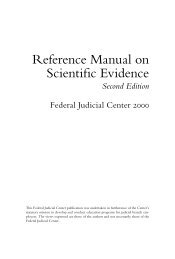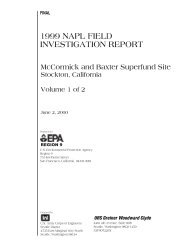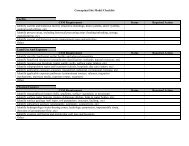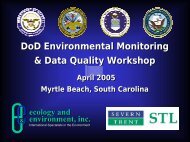Source Zone Delineation Demonstration Report - Triad Resource ...
Source Zone Delineation Demonstration Report - Triad Resource ...
Source Zone Delineation Demonstration Report - Triad Resource ...
Create successful ePaper yourself
Turn your PDF publications into a flip-book with our unique Google optimized e-Paper software.
4.0 SOIL VAPOR EXTRACTION DEMONSTRATIONMeasurement of vapor-phase TCE concentrations during SVE was conducted at OU 12 to help delineatesource-zone contamination in the vadose zone of the investigative area. The distribution of VOCs can beinferred by giving careful consideration to the vapor extraction operations, and by inverse numericalmodeling, either through a formal inversion scheme or through an iterative process of sequential forwardmodeling. The advantages of SVE as a characterization tool are the relative ease and low-cost ofimplementation, the large volume of the unsaturated zone affected and the extensive amount of datacollected as compared to soil borings, and the added benefit of active remediation occurringsimultaneously with characterization. Used in conjunction with conventional subsurface data, SVE canincrease the understanding of existing site conditions while decreasing the number of soil boringsrequired to obtain a valid representation of contaminant mass and potential migration pathways.The design of the SVE demonstration was based on data obtained from previous site investigation andcharacterization activities conducted at OU 12. These data were used to formulate the preliminary CSMand identify the initial monitoring/extraction well locations associated with the SVE demonstration. Thelocations of the soil vapor monitoring/extraction probes were refined based on the data obtained duringthe Wireline CPT demonstration.4.1 SVE Technical ApproachThe SVE demonstration was conducted in the suspected TCE source zone at OU 12 to obtain thefollowing information: Additional vadose zone characterization data in the suspected source zone at OU 12; In-situ air permeability as a function of space and time; Vent performance characteristics, such as capacities and subsurface vacuum distributions for variousextraction well locations; and Concentrations of TCE in the recovered vapor.The SVE demonstration focused on step tests for estimating TCE distribution within the suspected sourcezone at OU 12 using a multiphase, multicomponent numerical model. During the step tests, theconcentration of TCE in time was monitored via the on-site laboratory using DSITMS. The time-seriesdata collected during field operations will be compared with simulated time-series data using a theoreticaldistribution of TCE mass in the zone of influence and a sequential forward numerical modeling scheme.In addition, the data obtained during the step tests were used to assess the pneumatic response from thevadose zone at each vapor monitoring/extraction point.SVE data lends itself to a wide range of evaluation, including a simplified mass balance approach to moresophisticated multiphase, multicomponent numerical modeling in the unsaturated zone. A discussion ofvapor transport in unsaturated porous media as it relates to numerical modeling and characterization ofcontaminant mass in the vadose zone is provided in the Work Plan for the <strong>Source</strong> <strong>Zone</strong> <strong>Delineation</strong><strong>Demonstration</strong>, Operable Unit 12, Hill Air Force Base, Utah (URS, 2002).March 2003 4-1 OU 12 <strong>Demonstration</strong> <strong>Report</strong>Final










